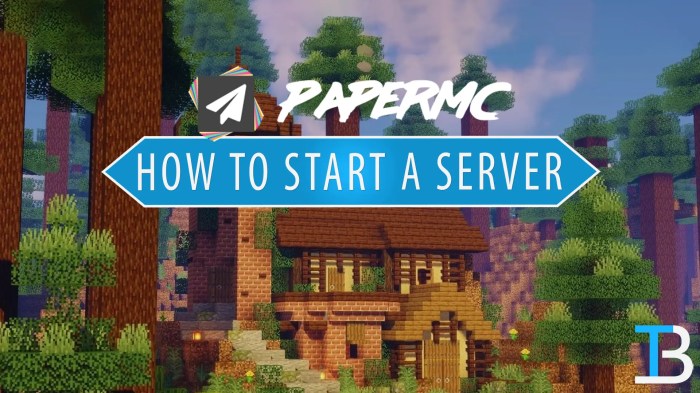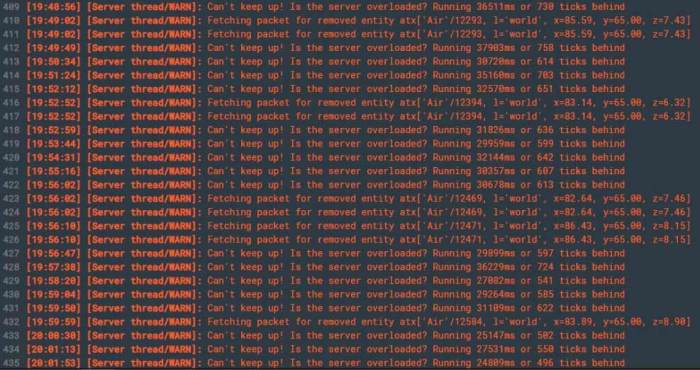When an MC server can’t keep up, the gaming experience can become frustrating and impede progress. This article delves into the various factors that contribute to server lag, providing insights and strategies to improve server performance.
From insufficient hardware resources to software optimization concerns, we explore the underlying issues that can cause server responsiveness to suffer. By understanding these causes, server administrators and players alike can take proactive measures to enhance the overall gaming experience.
MC Server Can’t Keep Up: Troubleshooting and Optimization

Minecraft servers are complex systems that require a balance of hardware, network, software, and player load to operate smoothly. When a server can’t keep up, it can lead to lag, disconnections, and other frustrating issues for players.
Insufficient Hardware Resources, Mc server can’t keep up

Insufficient hardware resources can severely impact server performance. Here are some key factors to consider:
- RAM:Low RAM can cause the server to run slowly and experience frequent crashes. Minecraft servers require at least 2GB of RAM, with 4GB or more recommended for optimal performance.
- CPU Cores:The number of CPU cores available to the server determines how many tasks it can handle simultaneously. A server with too few CPU cores will struggle to keep up with player activity, leading to lag and reduced responsiveness.
- Storage Space:Limited storage space can restrict the server’s ability to load and generate new worlds, as well as store player data and backups. Ensure the server has ample storage space to accommodate the needs of its player base.
Network Connectivity Issues
Network connectivity issues can also cause significant performance problems for Minecraft servers. Consider the following:
- High Latency:High latency (ping) between the server and players can result in delayed responses and laggy gameplay. Aim for a latency of less than 100ms for optimal performance.
- Packet Loss:Packet loss occurs when data packets are lost during transmission, disrupting communication between the server and players. Even small amounts of packet loss can cause noticeable lag and instability.
- Unstable Internet Connections:Unstable internet connections can lead to intermittent connectivity issues, causing players to disconnect or experience lag spikes. Ensure the server has a reliable internet connection with minimal downtime.
Software Optimization Concerns

Proper software optimization is crucial for server performance. Here are some recommendations:
- Server Software Configuration:Optimize server software settings, such as JVM arguments and resource allocation, to improve performance. Consider using a server optimization tool or consulting with experienced server administrators.
- Regular Software Updates:Keep server software up to date with the latest versions. Updates often include performance improvements and bug fixes that can significantly enhance server stability.
- Outdated Plugins or Mods:Outdated plugins or mods can introduce bugs and performance issues. Regularly review and update any installed plugins or mods to ensure they are compatible with the server software version.
Player Load and Server Capacity
Managing player load is essential to ensure server performance. Consider the following:
| Player Load | Recommended Server Capacity |
|---|---|
| 1-10 Players | 2GB RAM, 2 CPU Cores |
| 11-20 Players | 4GB RAM, 4 CPU Cores |
| 21-30 Players | 8GB RAM, 6 CPU Cores |
| 31-40 Players | 16GB RAM, 8 CPU Cores |
The optimal player load for a server depends on its hardware capabilities and software configuration. Aim to keep the player count within the recommended capacity to avoid performance issues.
Resource-Intensive Activities
Certain activities in Minecraft can strain server performance, including:
- World Generation:Generating new chunks or loading large worlds can be computationally intensive, especially on servers with limited resources.
- Large-Scale Player Events:Events such as PvP battles, server resets, or large gatherings can cause significant server load due to increased player activity and data processing.
Plan and manage these activities carefully to minimize their impact on server performance.
Query Resolution: Mc Server Can’t Keep Up
Why does my MC server lag during peak hours?
Player load can significantly impact server performance. Managing player count effectively, such as through queue systems or server upgrades, can help mitigate lag during high-traffic periods.
How can I improve the responsiveness of my MC server?
Ensuring sufficient hardware resources, optimizing server software configurations, and updating plugins and mods regularly can all contribute to improved server responsiveness.
What are some resource-intensive activities that can strain my server?
World generation, large-scale player events, and certain plugins or mods can place significant demands on server resources. Understanding these activities and managing them effectively can help prevent server overload.
